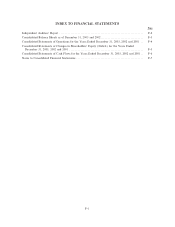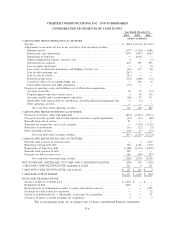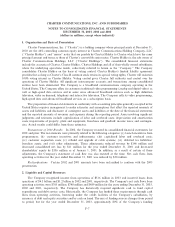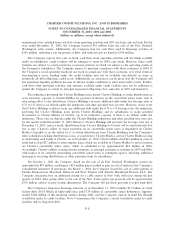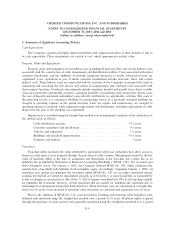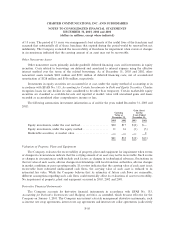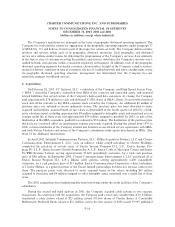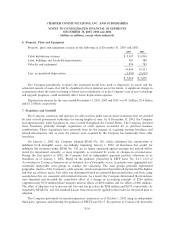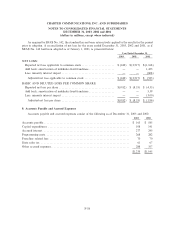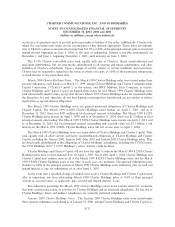Charter 2003 Annual Report Download - page 109
Download and view the complete annual report
Please find page 109 of the 2003 Charter annual report below. You can navigate through the pages in the report by either clicking on the pages listed below, or by using the keyword search tool below to find specific information within the annual report.CHARTER COMMUNICATIONS, INC. AND SUBSIDIARIES
NOTES TO CONSOLIDATED FINANCIAL STATEMENTS
DECEMBER 31, 2003, 2002 and 2001
(dollars in millions, except where indicated)
referred to herein as interest rate agreements) as required under the terms of the credit facilities of the
Company's subsidiaries. The Company's policy is to manage interest costs using a mix of Ñxed and variable
rate debt. Using interest rate swap agreements, the Company agrees to exchange, at speciÑed intervals, the
diÅerence between Ñxed and variable interest amounts calculated by reference to an agreed-upon notional
principal amount. Interest rate cap agreements are used to lock in a maximum interest rate should variable
rates rise, but enable the Company to otherwise pay lower market rates. Interest rate collar agreements are
used to limit exposure to and beneÑts from interest rate Öuctuations on variable rate debt to within a certain
range of rates. The Company does not hold or issue any derivative Ñnancial instruments for trading purposes.
Revenue Recognition
Revenues from residential and commercial video and high-speed data services are recognized when the
related services are provided. Advertising sales are recognized at estimated realizable values in the period that
the advertisements are broadcast. Local governmental authorities impose franchise fees on the Company
ranging up to a federally mandated maximum of 5% of gross revenues as deÑned in the franchise agreement.
Such fees are collected on a monthly basis from the Company's customers and are periodically remitted to
local franchise authorities. Franchise fees collected and paid are reported as revenues on a gross basis with a
corresponding expense pursuant to Emerging Issues Task Force (""EITF'') Issue No. 01-14, Income
Statement Characterization of Reimbursements Received for 'Out of Pocket' Expenses Incurred.
Programming Costs
The Company has various contracts to obtain analog, digital and premium video programming from
program suppliers whose compensation is typically based on a Öat fee per customer. The cost of the right to
exhibit network programming under such arrangements is recorded in operating expenses in the month the
programming is available for exhibition. Programming costs are paid each month based on calculations
performed by the Company and are subject to adjustment based on periodic audits performed by the
programmers. Additionally, certain programming contracts contain launch incentives to be paid by the
programmers. The Company receives these payments related to the promotion and activation of the
programmer's cable television channel and recognizes the launch incentives on a straight-line basis over the
life of the programming agreement as a reduction of programming expense. This oÅset to programming
expense was $62 million, $57 million and $35 million for the years ended December 31, 2003, 2002 and 2001,
respectively. Programming costs included in the accompanying statement of operations were $1.2 billion,
$1.2 billion and $963 million for the years ended December 31, 2003, 2002 and 2001, respectively. As of
December 31, 2003 and 2002, the deferred amount of launch incentives, included in other long-term liabilities,
totaled $148 million and $210 million, respectively.
Advertising Costs
Advertising costs associated with marketing the Company's products and services are generally expensed
as costs are incurred. Such advertising expense was $62 million, $60 million and $43 million for the years
ended December 31, 2003, 2002 and 2001, respectively.
Stock-Based Compensation
The Company has historically accounted for stock-based compensation in accordance with Accounting
Principles Board (""APB'') Opinion No. 25, Accounting for Stock Issued to Employees, and related
interpretations, as permitted by SFAS No. 123, Accounting for Stock-Based Compensation. On January 1,
2003, the Company adopted the fair value measurement provisions of SFAS No. 123 using the prospective
F-11


